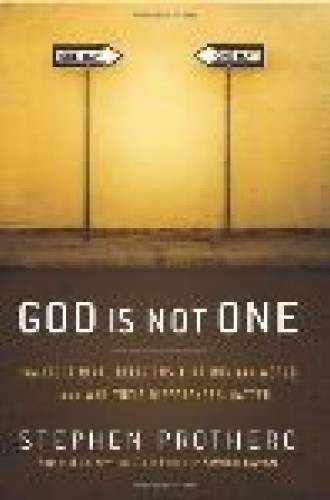God Is Not One: The Eight Rival Religions That Run the World—and Why Their Differences Matter
The tradition known as the perennial philosophy has long argued that all of the world’s religions lead ultimately to the same goal. As expressed by the so-called Traditionalist or Peren nialist School of René Guénon, Frithjof Schuon, Huston Smith and Seyyed Hossein Nasr, this approach distinguishes the exoteric level of religious expression and belief, where there are obvious and important differences, from the esoteric, mystical dimension, where the differences are not of decisive importance. It does not deny differences but argues that all paths converge toward the same end. In recent decades, the discipline of religious studies has seen a sharp backlash against these sweeping claims. So great has the skepticism been that many scholars have questioned the merits of any broad comparative efforts at all.
Stephen Prothero attacks the perennial philosophy, but he passes over the entire scholarly debate in silence and leads his readers to believe that the field of religious studies today is predominantly represented by perennialists. By failing to note that many scholars have long since critiqued the Perennialist School, Prothero presents his negative appraisal as appearing to be more original than it is.
The title God Is Not One proclaims a provocative, possibly polytheistic wager. However, Prothero never presents a serious theory of religious difference; nor does he engage the arguments of the perennialist philosophers; nor does he explain how these religions run the world. Instead, he presents a journalistic description of phenomenological differences. Any astute defender of the Perennialist School would, of course, readily acknowledge the kind of surface differences that Prothero notes. The serious philosophical question concerns the assessment of difference: What difference do the differences make? Or, as the late scholar Joseph Kitagawa used to ask, “Are we singing the same song?”
Prothero tells us that the differences matter because ignoring differences contributes to religiously motivated violence. Prothero cites Gandhi’s assertion that “belief in one God is the cornerstone of all religions,” and he charges that “this naive theological groupthink—call it Godthink—has made the world more dangerous by blinding us to the clashes of religions that threaten us worldwide.” Given the context of Gandhi’s life and death, it is strange to tell Gandhi that he was blind to the clashes of religions. Prothero never explains exactly how Gandhi’s confidence contributed to religiously motivated violence.
While Prothero’s title raises the tantalizing prospect of a radical pluralism, he does not pursue this option but instead proposes a more comfortable convergence of his own. Making a distinction between ethics on the one hand and “doctrine, ritual, mythology, experience, and law” on the other, Prothero tells us that different religions converge in matters of ethics and diverge in the other areas. However, he never clearly explains how different approaches to ethics can converge while experience and law diverge.
In this sequel to his Religious Literacy: What Every American Needs to Know—And Doesn’t, Prothero promises the reader assistance in gaining religious literacy. However, he makes a surprising number of mistakes and misleading claims of his own. Even though Genesis tells us that God promised Abraham the land he could see all around him (Gen. 13:14–15), Prothero tells his readers that Abraham never reached the Promised Land.
Prothero tells us that the Dome of the Rock atop the Temple Mount is a mosque, even though it is not. Prothero asserts that the Temple was on the site of the Dome of the Rock, even though this is not known for certain; a number of scholars today believe that the Temple was either further south or north of the Dome of the Rock. Though rabbinic Judaism developed in the centuries after the destruction of the Second Temple in 70 CE, Prothero tells us that “Judaism as we know it today developed between” 586 BCE and 70 CE. Prothero tells us that the architecture of the Indus Valley dates from 2500 to 1500 BCE and thus is “older than the pyramids.” Egyptol ogists date the first pyramids to ca. 2700 BCE.
A number of other claims are puzzling. Prothero asserts that in Islam, Muhammad “did the work of Jesus and Paul combined.” One page later he quite properly cites the noted Christian scholar of Islam Wilfred Cantwell Smith, who consistently argued that in Islam it is the Qur’an that is truly comparable to the significance of Jesus in Christian faith. Prothero does not note the profound difference between his claim and Smith’s. Prothero tells us that the Protestant Reformers were like “devotional Hindus,” since for both traditions “the religious goal could be attained by all who offered up their everyday activities to the divine.” Surely this description would come as surprising news to Martin Luther and John Calvin.
Despite his insistence on differences, Prothero’s personal conclusion is like Rainer Maria Rilke’s: that we should “love the questions” in an undogmatic, agnostic religiosity in which the differences seem to lose their importance after all. Prothero ends his discussion by writing: “Any genuine belief in what we call God should humble us, remind us that, if there really is a god or goddess worthy of the name, He or She must surely know more than we do about the things that matter most. This much, at least, is shared across the great religions.” Unfortu nately, Prothero never fulfills the promise of his challenging title.






